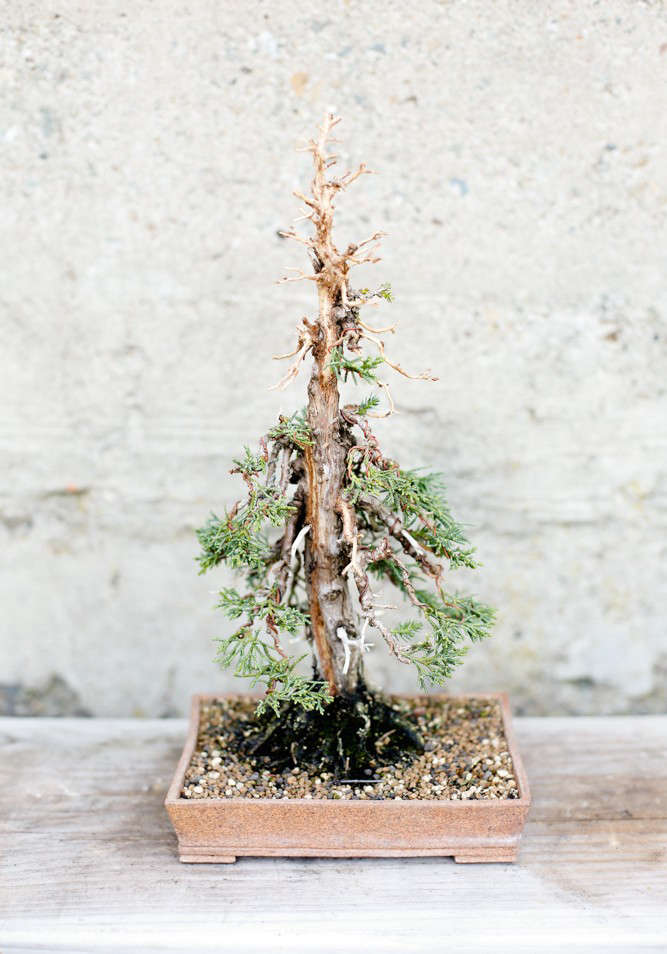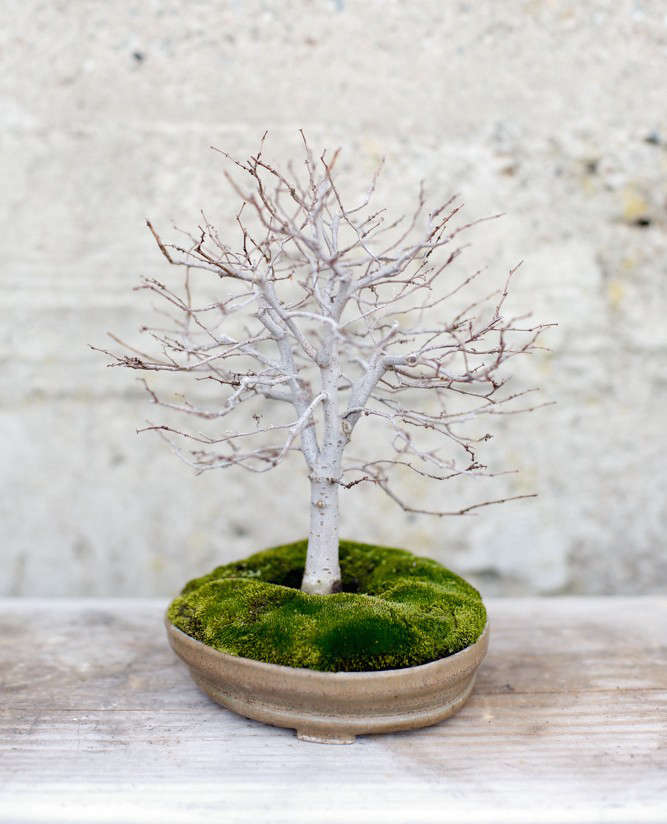Tiny, tortured bonsai trees that look wise beyond their years fascinate me. What separates them from their shopping mall cousins—shelves of identical plants, each with a tiny clay Confucius at its roots?
To find out, I went to visit Eric Schrader, who teaches bonsai basics at the Bonsai Society of San Francisco and who lives in an impressive bonsai forest (in his backyard). He remembers discovering bonsai—at the San Francisco Flower and Garden Show—more than a decade ago. There, amid a giant bonsai exhibit that sprawled over thousands of square feet, was one tree that captivated him: a redwood that looked like nothing more than a scrap of bark. “I like the tortured trees,” he says.
I peppered him with questions: What is bonsai? How do you grow one? How do you shape it?
“There are artistic principles at play,” Eric said, “if you want the tree to speak to you.” Oh, I do:
Photography by Luke Abiol for Gardenista.

Gardenista: First things first: what is bonsai?
Eric Schrader: Bonsai is a set of techniques–coupled with a plant that will react to those techniques in a way you like. You could use almost any plant of a woody structure to make a bonsai.
GD: What is the most important thing for a beginner to know?
ES: That bonsai is not an indoor plant. The only types that grow indoors are tropical varieties; the rest naturally grow outdoors. Juniper, which is the common bonsai sold in stores, will die inside. If taken care of, it might last two or three years. But most bonsai want a winter dormancy period–at least six weeks of rest in the winter when they’re not growing. Plus, indoors they don’t get the light they need and it’s too easy to overwater them.
GD: Are there rules about what shapes your bonsai can take?
ES: Not rules, but five basic shapes: formal upright, informal upright, slant, semi-cascade, and cascade.







GD: What species do you recommend for a beginner tree?
ES: I like Cotoneaster microphyllus; it’s the plant I use in the basics class. If kept healthy, cotoneaster exhibits satisfying changes with the seasons: it blooms profusely in the spring with small white flowers and sets red berries in winter.
GD: How often should a bonsai be trimmed?
ES: It depends entirely on the species of plant and how quickly it grows. Cotoneaster must be trimmed four, five, maybe six times a year. So each time you trim you have an opportunity to improve the tree. But some plants only grow half an inch to an inch a year–those you have very little opportunity to improve.
Either way, people often make the mistake of continuously trimming their plants. This slows the plant’s metabolism. Instead, you should let it grow out a little bit before cutting back. But, the downside to this is that the branches can get too thick while they’re waiting to be trimmed.
GD: How do you know what shape your tree should take?
ES: Usually, the plant will suggest a shape and you take that suggestion and try to refine it. You eliminate a bunch of stuff you don’t want the tree to use, and the plant in turn says, “Okay, I will do that” or “I will not.”
People seem to be surprised at the repetitive nature of working with bonsai. In the beginning, you make a relatively drastic change, then stop. Then you take what the plant did with your change and keep the parts that work and change the parts that don’t. You continue repeating that process.

GD: What are the soil and drainage requirements for bonsai?
ES: Bonsai need free-draining soil. I use a mix of one-third each of pumice, lava rock, and akadama (which means “red ball” in Japanese). The size of the soil “rocks” should be relative to the size of the container or plant. When you water the tree, the water should go straight through the soil. As it drains out the bottom, it should suck air in through the soil mixture and deliver air to the roots.

GD: What kind of care and feeding does bonsai require?
ES: Bonsai won’t grow without fertilizer. It’s confined to a tiny container with low-nutrient soil, and eventually all the nutrients will be exhausted.
Gauge your plant’s water needs the way you would with any other plant: feel the soil about an inch below the surface. But a general tip is to water bonsai every day during the growing season and every other day in dormancy.
Bonsai also require repotting every one to three years. During the dormancy periods, you need to trim the roots–sometimes you’ll cut off upwards of 80 percent–and replant it in a smaller pot. To a beginner, this can be a little bit scary; some experience helps here.
GD: What is the biggest bonsai killer?
ES: Overwatering.

GD: Any basic techniques you can share with the beginner?
ES: You don’t want any tool marks on your tree, so after cutting off a branch I’ll eventually clean up the little stubs so they look more natural. I use pliers to twist and smash the spot where I cut the branch, so that it doesn’t look cut; it looks broken by nature. I like to let the dead wood evolve like the branches. I’ll make an adjustment, let it dry, then maybe make another later on.
One trick to getting this look without cutting is to kill a branch by removing its bark. When you want a branch gone, use the pliers to smash the bark and peel it from the branch. Once the bark is gone, the branch will die, and you can then break the branch by snapping it off so it looks natural, not cut.

GD: What does it take to be a good bonsai gardener?
ES: There are three main facets of bonsai care: the horticulture, the aesthetics, and the practical. For the horticulture–can you assess the health of your plant? Can you tell if it has a nutrient problem? The aesthetics–can you take something confusing, like a bushy tree–and distill it down to the most interesting part? And the practical–can you take a wire and wrap it around a branch? Some people can’t.
Keep in mind that the artistic aspect is not what you’ll need to keep your bonsai alive. The plants themselves are not especially complicated to grow, but you must pay attention to what the plant is telling you.
GD: Be honest. How many have you killed?
ES: I’ve really never killed a bunch of them–I have always had a pretty good instinct for the horticulture aspect. Still, every once in a while there’s one. It drives me insane: I have 12 years or better experience in something I consider to be my main interest, and I’m confounded by a plant that has decided it won’t live under my care.

GD: What is the oldest tree in your collection?
ES: A large juniper I collected from a forest, estimated to be 700 to 800 years old. (A rule of thumb for age is 100 years per inch of girth.) It wasn’t always a bonsai, of course. Trees growing in harsh environments like a rocky outcropping will grow very slowly. A wild plant in that kind of environment will struggle for decades or even centuries, which makes for a very old but very small tree.
GD: Is it legal to collect from a forest?
ES: It’s legal. You can of course collect plants on private property, and the Forest Service and the Bureau of Land Management will both issue plant collection permits, just like they will issue permits for logging or cutting down a Christmas tree.

GD: You’ve mentioned wiring. Does a beginner need to learn how to wire a tree?
ES: My teacher says, “Bonsai is wiring and wiring is bonsai.” There is a bonsai tradition that predates wiring, but when people started using wire, bonsai went from looking unkempt to becoming the exact shape people wanted. There is still a bonsai style of directional pruning that does not use wire, but it takes 10 years to accomplish something you could do in two years with wire.

GD: What is the value of moss beneath the tree?
ES: The moss is an aesthetic thing. On some of my plants, the moss has grown on its own and I just haven’t pulled it back yet. On others, it’s compositional. Most bonsai people collect wild moss to use in exhibiting, but I try to grow it under the benches in my garden.

GD: What belongs in a beginner’s tool kit?
ES: If you only have a few plants, you just need scissors. When I began getting serious with bonsai, I bought a pair of $200 Masakuni scissors–the brand is the Rolls-Royce of bonsai tools–thinking I would use them for decades so I’d invest in a good pair once. But it turns out I use a $20 pair most often. (His are ARS Straight Blade Cultivation Scissors, available for $22.55 on Amazon.) I like the length, grip, and the fine tip. The second most important tool is a pair of tweezers. I use a pair of German surgical tweezers I found in Japan, but visit Stone Lantern for a good starter pair.

GD: Where should a beginner go to get started?
ES: In the US, most people join bonsai clubs to start out. Take a class, watch a demonstration–the best way to learn is definitely hands-on.
Visit Eric’s blog, Phutu, for more on bonsai, including Thoughts on Tools and Deadwood Details. Visit the Bonsai Society of San Francisco for Eric’s tips on The Very Basics and Pearls of Bonsai Wisdom.
Sufficiently bonsai-obsessed? See:
N.B.: This is an update of a post published October 20, 2014.










Have a Question or Comment About This Post?
Join the conversation